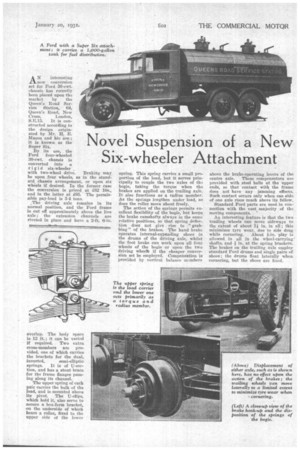Novel Suspension of a New Six-wheeler Attachment
Page 63

If you've noticed an error in this article please click here to report it so we can fix it.
AN interesting new conversion set for Ford 30-cwt. chassis has recently been placed upon the market by the Queen's Road Service Station, 64, Queen's Road, New
Cross, London, S.E.15. It is con structed according to the design originated by Mr. H. E. Mason and his ton; it is known as the Super Six.
By its use, the Ford four-wheeled 30-cwt. chassis is converted into a rigid six-wheeler _ with two-wheel drive. Braking may be upon four wheels, as in the standard chassis arrangement, or upon six wheels if desired. In the former case the conversion is priced at £82 108., and in the latter at £95. The permissible pay-load is 3-4 tons.
The driving axle remains in its normal position, and the Ford frame is cut off approximately above the live axle ; the extension channels are riveted in place and have a 2-ft, 6-in.
VAMA12,1,151, NM ft:7,MM 'MOW, ....te.M1VOMAN*,,,,,
overlap. The body space is 12 ft.; it can be varied if required. Two extra cross-members are provided, one of which carries the brackets for the dual, inverted, semi-elliptic springs. It is of II-sec tion, and has a stout brace for the frame flanges passing along its channel.
The upper spring of each pair carries the bulk of the load, and is mounted above its pivot. The U-clips, which hold it, also serve to secure a box-form bracket, on the underside of which bears a roller, fixed to the upper side of the lower spring. This spring carries a small proportion of the load, but it serves principally to couple the two axles of the bogie, taking the torque when the brakes are applied on the trailing axle. It also functions as a radius member. As the springs lengthen under load, so does the roller move about freely.
The action of the springs permits excellent flexibility of the bogie, but keeps the brake camshafts always in the same relative positions, so that spring deflection does not give rise to " grabbing" of the brakes. The hand brake .operates internal-expanding shoes in the drums of the driving axle, whilst the-foot brake can work upon all four wheels of the bogie or unon the two driving wheel if the cheaperconversion set be employed. Compensation is provided by vertical balance mcmbers
above the brake-operating levers of the centre axle. These compensators are provided with steel balls at the upper ends, so that contact with the frame does not have any jamming effects. Such contact occurs only when one -side of one axle rises much above its fellow.
Standard Ford parts are used in connection with the vast majority of the moving components. • An interesting feature is that the two trailing wheels can move sideways to the extent of about 1i in. in all ; this minimises tyre wear, due to side drag while cornering. About i-in. play is allowed in all in the wheel-carrying' shafts, and in. at the spring brackets. The brakes on the trailing axle employ standard Ford drums and single pairs of shoes; the drums float laterally when cornering, but the shoes are fixed.












































































































